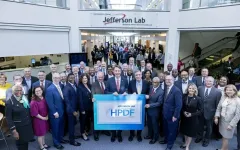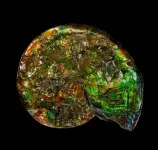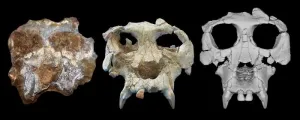(Press-News.org) Previous research has implicated fungi in chronic neurodegenerative conditions such as Alzheimer’s disease, but there is limited understanding of how these common microbes could be involved in the development of these conditions.
Working with animal models, researchers at Baylor College of Medicine and collaborating institutions discovered how the fungus Candida albicans enters the brain, activates two separate mechanisms in brain cells that promote its clearance, and, important for the understanding of Alzheimer’s disease development, generates amyloid beta (Ab)-like peptides, toxic protein fragments from the amyloid precursor protein that are considered to be at the center of the development of Alzheimer’s disease. The study appears in the journal Cell Reports.
“Our lab has years of experience studying fungi, so we embarked on the study of the connection between C. albicans and Alzheimer's disease in animal models,” said corresponding author Dr. David Corry, Fulbright Endowed Chair in Pathology and professor of pathology and immunology and medicine at Baylor. He also is a member of Baylor’s Dan L Duncan Comprehensive Cancer Center. “In 2019, we reported that C. albicans does get into the brain where it produces changes that are very similar to what is seen in Alzheimer’s disease. The current study extends that work to understand the molecular mechanisms.”
“Our first question was, how does C. albicans enter the brain? We found that C. albicans produces enzymes called secreted aspartic proteases (Saps) that breakdown the blood-brain barrier, giving the fungus access to the brain where it causes damage,” said first author Dr. Yifan Wu, postdoctoral scientist in pediatrics working in the Corry lab.
Next, the researchers asked, how is the fungus effectively cleared from the brain? Corry and his colleagues had previously shown that a C. albicans brain infection is fully resolved in otherwise healthy mice after 10 days. In this study, they reported that this occurred thanks to two mechanisms triggered by the fungus in brain cells called microglia.
“The same Saps that the fungus uses to break the blood-brain barrier also break down the amyloid precursor protein into AB-like peptides,” Wu said. “These peptides activate microglial brain cells via a cell surface receptor called Toll-like receptor 4, which keeps the fungi load low in the brain, but does not clear the infection.”
C. albicans also produces a protein called candidalysin that also binds to microglia via a different receptor, CD11b. “Candidalysin-mediated activation of microglia is essential for clearance of Candida in the brain,” Wu said. “If we take away this pathway, fungi are no longer effectively cleared in the brain.”
“This work potentially contributes an important new piece of the puzzle regarding the development of Alzheimer’s disease,” Corry said. “The current explanation for this condition is that it is mostly the result of the accumulation of toxic Ab-like peptides in the brain that leads to neurodegeneration. The dominant thinking is that these peptides are produced endogenously, our own brain proteases break down the amyloid precursor proteins generating the toxic Ab peptides.”
Here, the researchers show that the Ab-like peptides also can be generated from a different source – C. albicans. This common fungus, which has been detected in the brains of people with Alzheimer’s disease and other chronic neurodegenerative disorders, has its own set of proteases that can generate the same Ab-like peptides the brain can generate endogenously.
“We propose that the brain Ab-peptide aggregates that characterize multiple Candida-associated neurodegenerative conditions including Alzheimer’s disease, Parkinson’s disease and others, may be generated both intrinsically by the brain and by C. albicans,” Corry said. “These findings in animal models support conducting further studies to evaluate the role of C. albicans in the development of Alzheimer’s disease in people, which can potentially lead to innovative therapeutic strategies.”
For a complete list of the contributors to this work, their affiliations and the financial support for this project, see the publication.
###
END
Fungal infection in the brain produces changes like those seen in Alzheimer’s disease
2023-10-16
ELSE PRESS RELEASES FROM THIS DATE:
Jefferson Lab to lead $300+ million high performance data facility hub
2023-10-16
NEWPORT NEWS, VA – The U.S. Department of Energy has just announced the selection of Thomas Jefferson National Accelerator Facility as the lead for its new High Performance Data Facility Hub. Jefferson Lab will partner with DOE’s Lawrence Berkeley National Laboratory to form a joint project team led by Jefferson Lab. The HPDF will be a $300-500 million computing and data infrastructure resource that will provide transformational capabilities for data analysis, networking and storage for the nation’s research enterprise. ...
VA study provides new insights into COVID-19 pandemic death rates
2023-10-16
A multi-institutional team of researchers led by the White River Junction VA, and including the West Haven and Palo Alto VA, analyzed electronic health record data from more than 5.9 million Veterans―spanning both pre-pandemic (March 2018 - February 2020) and pandemic (March 2020 - February 2022) periods―to discover nuanced insights from COVID-19’s impact on mortality rates.
While former studies have primarily relied on aggregate data, this research―published in the October 2023 issue of the International Journal of Epidemiology―offered a unique perspective ...
Leading scientists, philosophers identify nature’s missing evolutionary law
2023-10-16
A paper in the prestigious Proceedings of the National Academy of Sciences today describes “a missing law of nature,” recognizing for the first time an important norm within the natural world’s workings.
In essence, the new law states that complex natural systems evolve to states of greater patterning, diversity, and complexity. In other words, evolution is not limited to life on Earth, it also occurs in other massively complex systems, from planets and stars to atoms, minerals, and more.
Authored by a nine-member team — leading scientists from the Carnegie Institution for ...
Study shows long-term health impacts after exposure to environmental disaster
2023-10-16
Exposure to a large-scale disaster, such as a tsunami, impacts population health over a decade later. A new study by an inter-disciplinary team of researchers in the United States and Indonesia has found that women who lived along the coast of Aceh, Indonesia when it was hit by waves from the 2004 tsunami have lower cortisol levels 14 years later than women who lived in other, nearby coastal communities that were not directly affected.
Cortisol is a stress hormone produced by the adrenal glands. Cortisol levels rise in response to stress as part of the fight or flight response, but consistently elevated ...
Extinct ape gets a facelift, 12 million years later
2023-10-16
A new study led by scientists at the American Museum of Natural History, Brooklyn College, and the Catalan Institute of Paleontology Miquel Crusafont has reconstructed the well-preserved but damaged skull of a great ape species that lived about 12 million years ago. The species, Pierolapithecus catalaunicus, may be crucial to understanding great ape and human evolution. The researchers describe their findings today in the journal Proceedings of the National Academy of Sciences.
Pierolapithecus catalaunicus, a species from northeastern Spain first described in 2004, was one of a diverse group of now-extinct ...
Signatures of the Space Age: Spacecraft metals left in the wake of humanity’s path to the stars
2023-10-16
WEST LAFAYETTE, Ind. – The Space Age is leaving fingerprints on one of the most remote parts of the planet — the stratosphere — which has potential implications for climate, the ozone layer and the continued habitability of Earth.
Using tools hitched to the nose cone of their research planes and sampling more than 11 miles above the planet’s surface, researchers have discovered significant amounts of metals in aerosols in the atmosphere, likely from increasingly frequent launches and returns of spacecraft and satellites. That mass of metal is changing atmospheric chemistry in ways that ...
Stress levels worse in women who have heart attacks with blockages, study finds
2023-10-16
Stress and depression are known to increase risk of heart attack, especially among women. They’ve also been linked to worse recovery. But does stress and depression contribute more to women with heart attacks with open arteries or blocked arteries? That’s what a new study published in the Journal of the American College of Cardiology aimed to find out.
Researchers found stress and depression were indeed common among women at the time of heart attack and for two months after. But they also found that women with heart attacks due to blockages (MI-CAD) in their coronary arteries had higher ...
The new robot is taking its first intuitive steps
2023-10-16
When walking on the sidewalk, a person is able to avoid puddles, other walkers, and cracks in the pavement. It may seem intuitive – and that's because it is.
There’s actually a biological component that allows humans and other mammals to navigate our complex environments. Central Pattern Generators (CPG) are neural networks that produce rhythmic patterns of control signals for limbs using simple environmental cues. When we quickly step away to avoid something blocking our path, that’s ...
Neutrons see stress in 3D-printed parts, advancing additive manufacturing
2023-10-16
Using neutrons to see the additive manufacturing process at the atomic level, scientists have shown that they can measure strain in a material as it evolves and track how atoms move in response to stress.
The automotive, aerospace, clean energy and tool-and-die industries — any industry that needs complex and high-performance parts — could use additive manufacturing,” said Alex Plotkowski, materials scientist in ORNL’s Materials Science and Technology Division and the lead scientist of the experiment. Plotkowski and his ...
How to tell if your boss is a ‘corporate psychopath’
2023-10-16
Findings from research to help the business world identify destructive ‘corporate psychopaths’ will be presented at the Chelmsford Science Festival on Monday, 23 October.
Dr Clive Boddy of Anglia Ruskin University, a pioneer in the field of corporate psychopathy, will discuss his research, published in the International Journal of Market Research, looking at how the financial industry can identify, manage and, if necessary, remove these individuals.
Around 1% of the adult population are ...




